Abstract
Appropriate regulation of reproductive processes are dependent upon the integrity of pituitary function. In this selected review, we evaluate the evidence that certain environmental compounds exert their effect on reproductive function via a direct action on the pituitary gland. We also discuss examples of changes in pituitary hormone secretion that occur in response to changes in neuronal or gonadal control of the pituitary. A limited number of studies suggest that measures of pituitary hormone secretion provide an early and sensitive measure of a compound's potential effects on the reproductive system. However, the most striking aspect of this area is the sparse and inconsistent information describing pituitary function following exposure to environmental pollutants.
Full text
PDF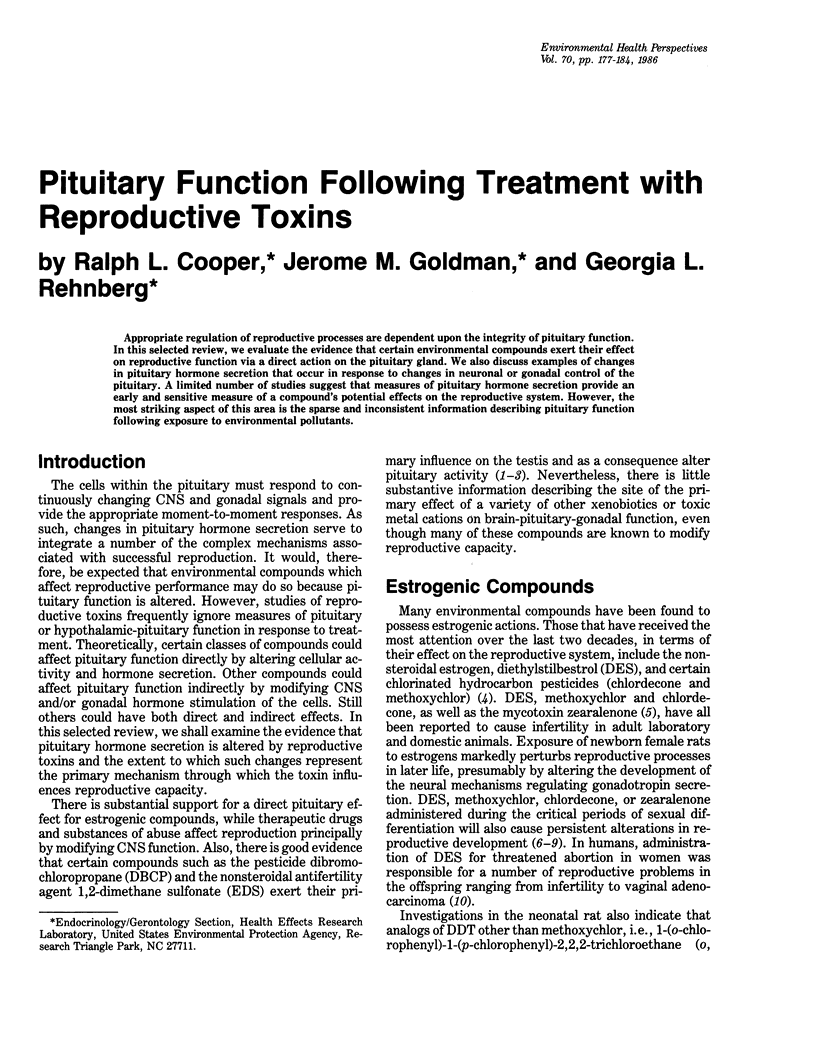
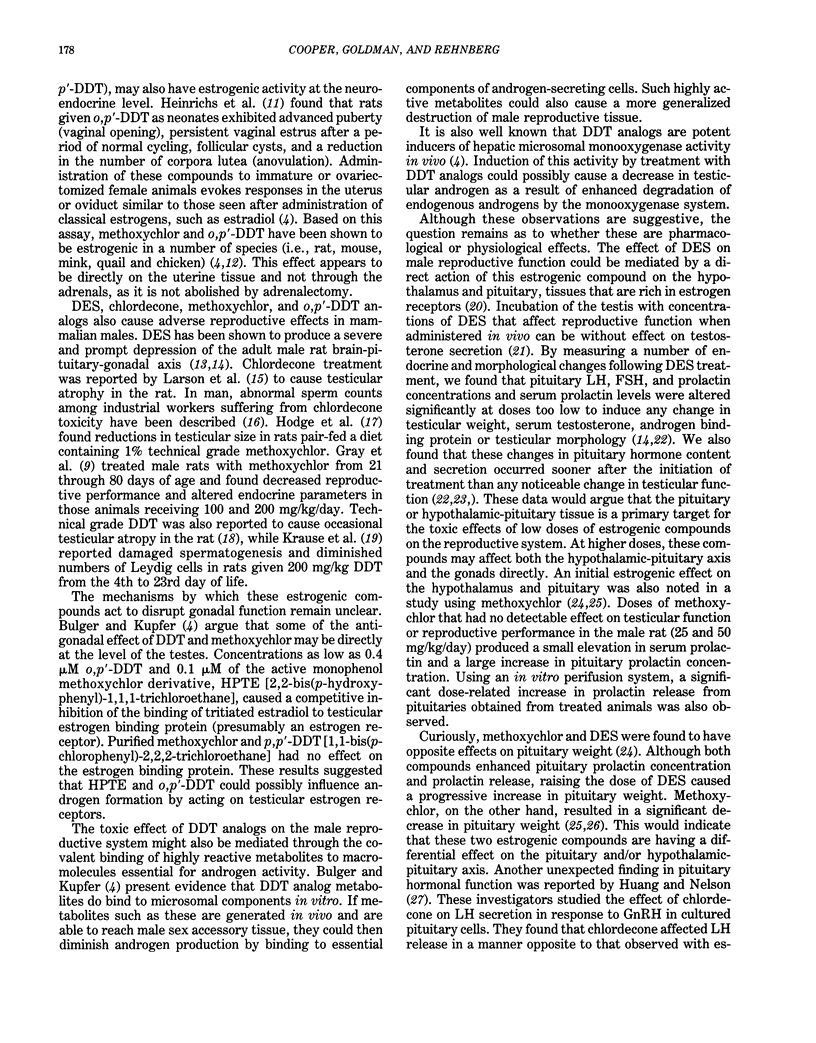
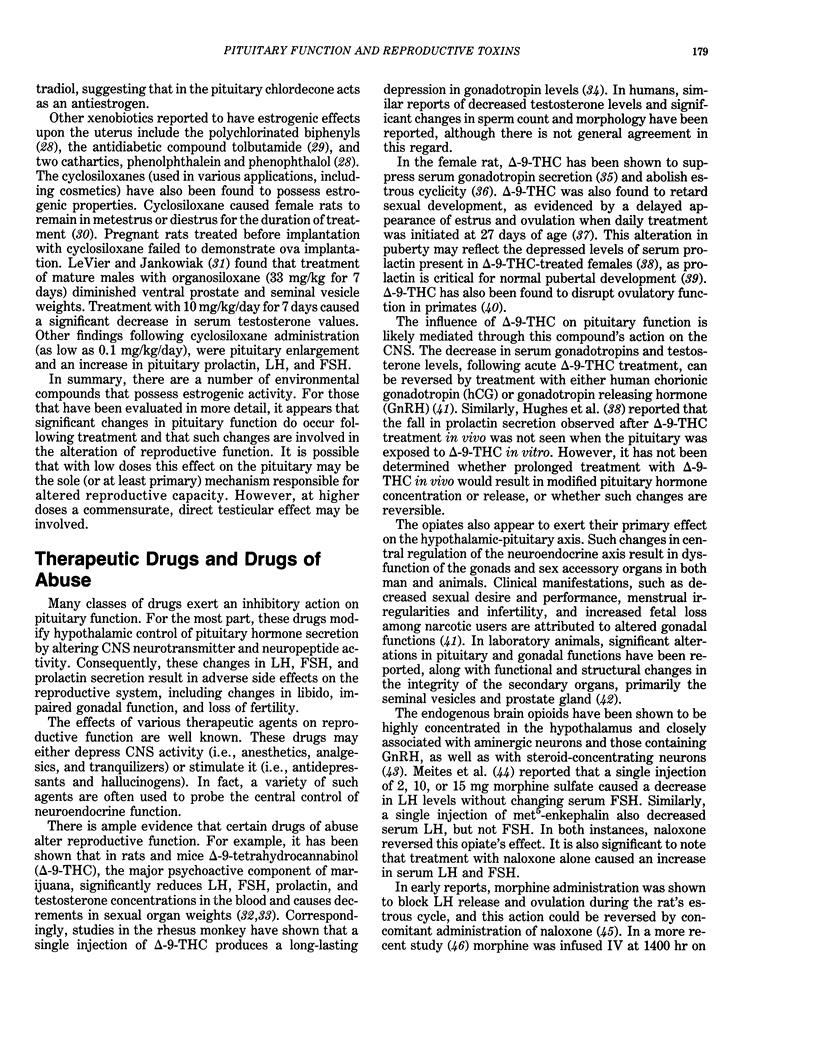
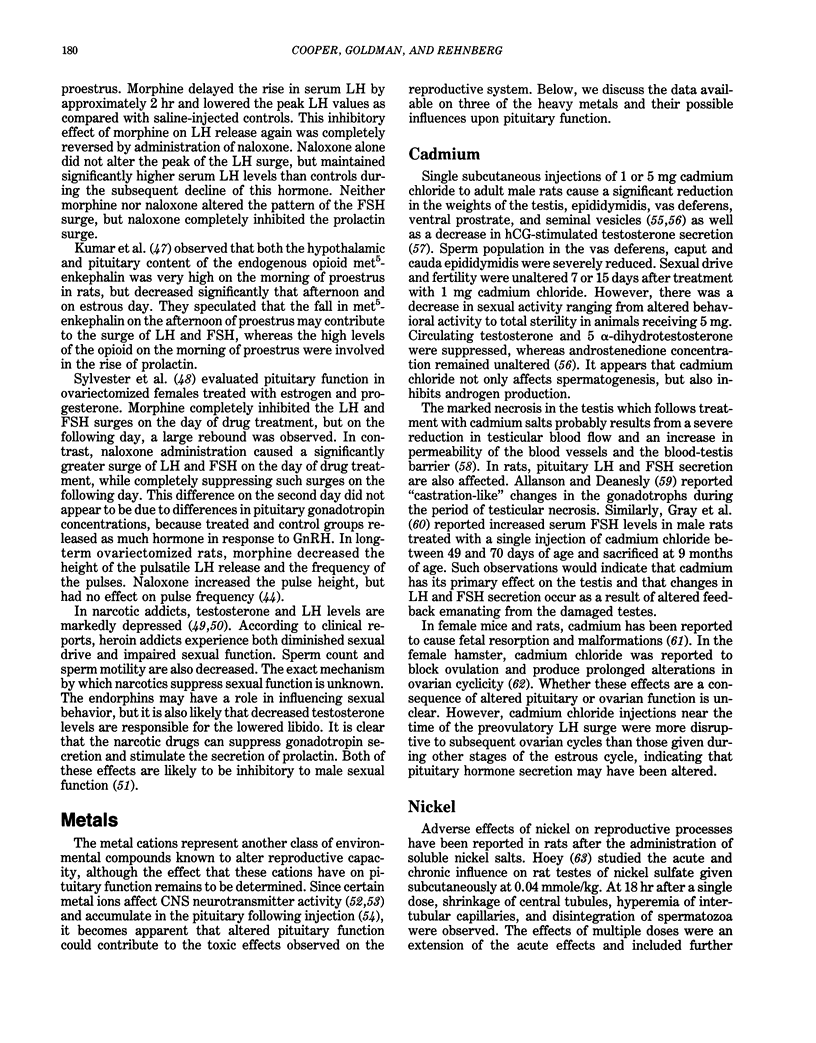
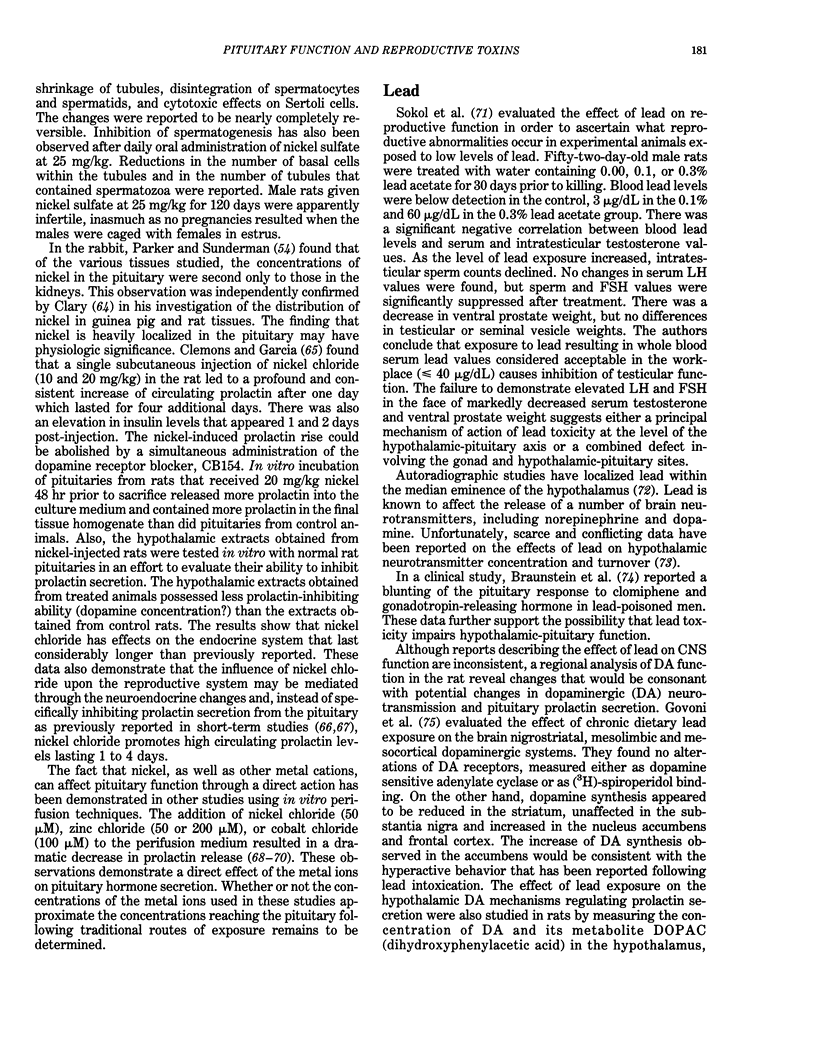
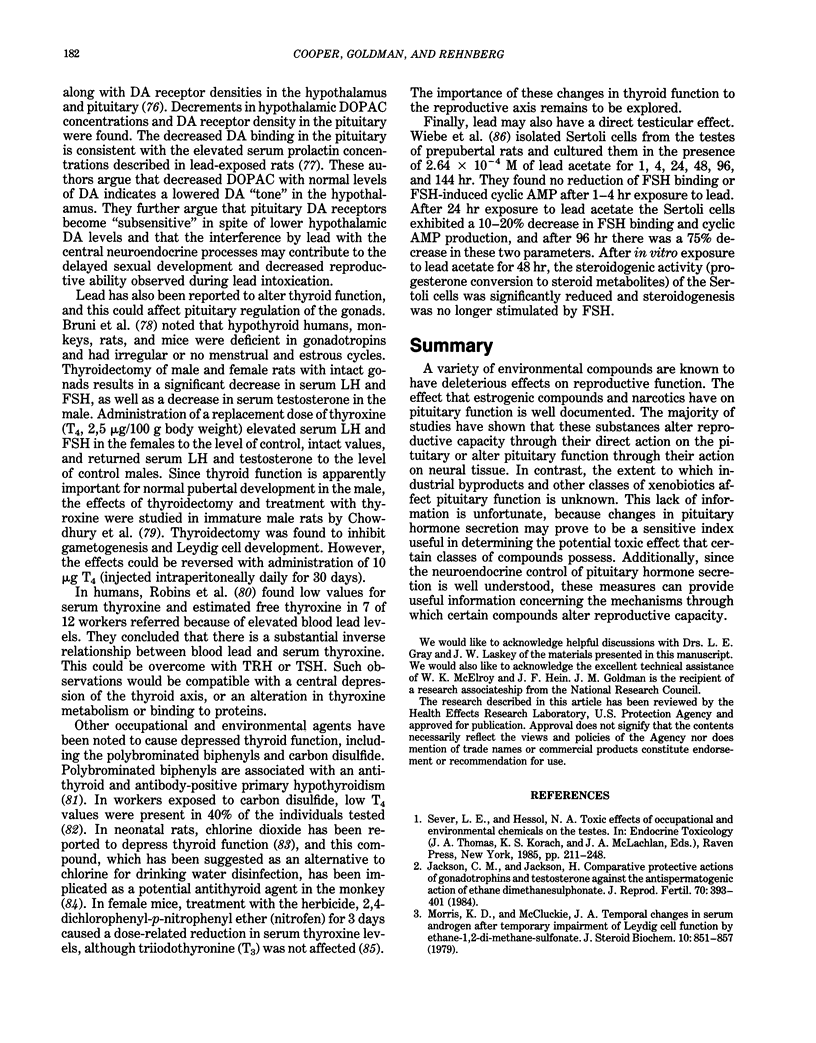
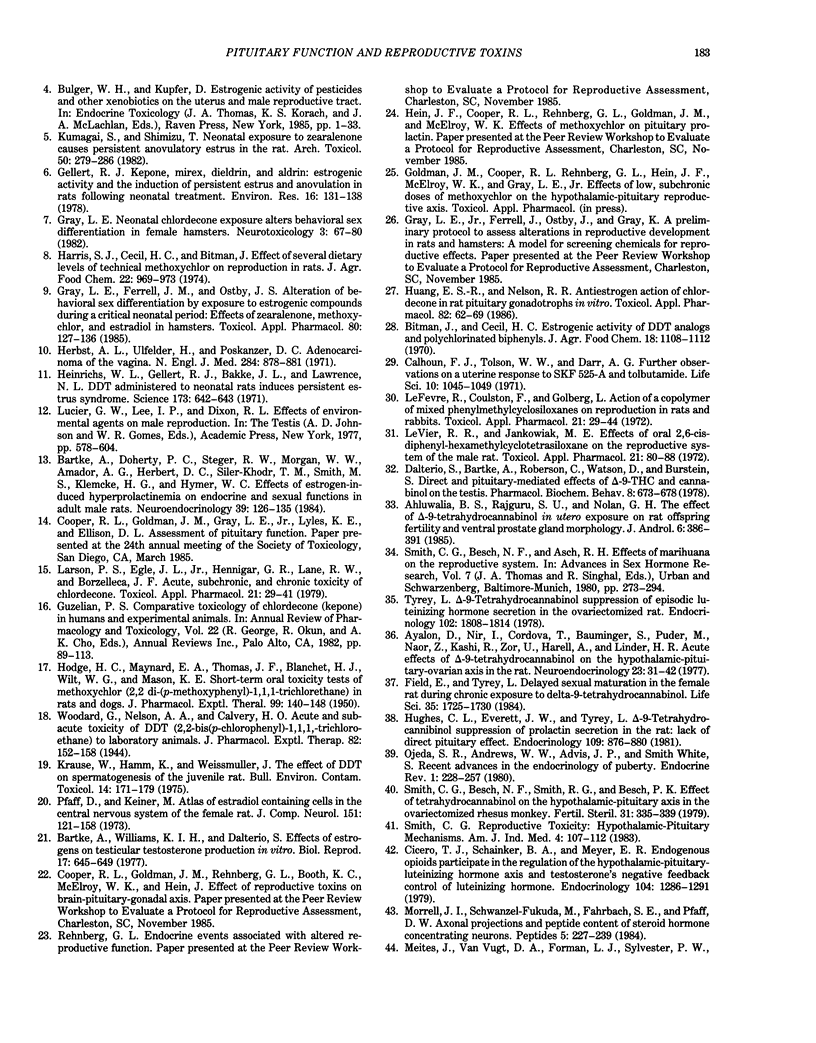
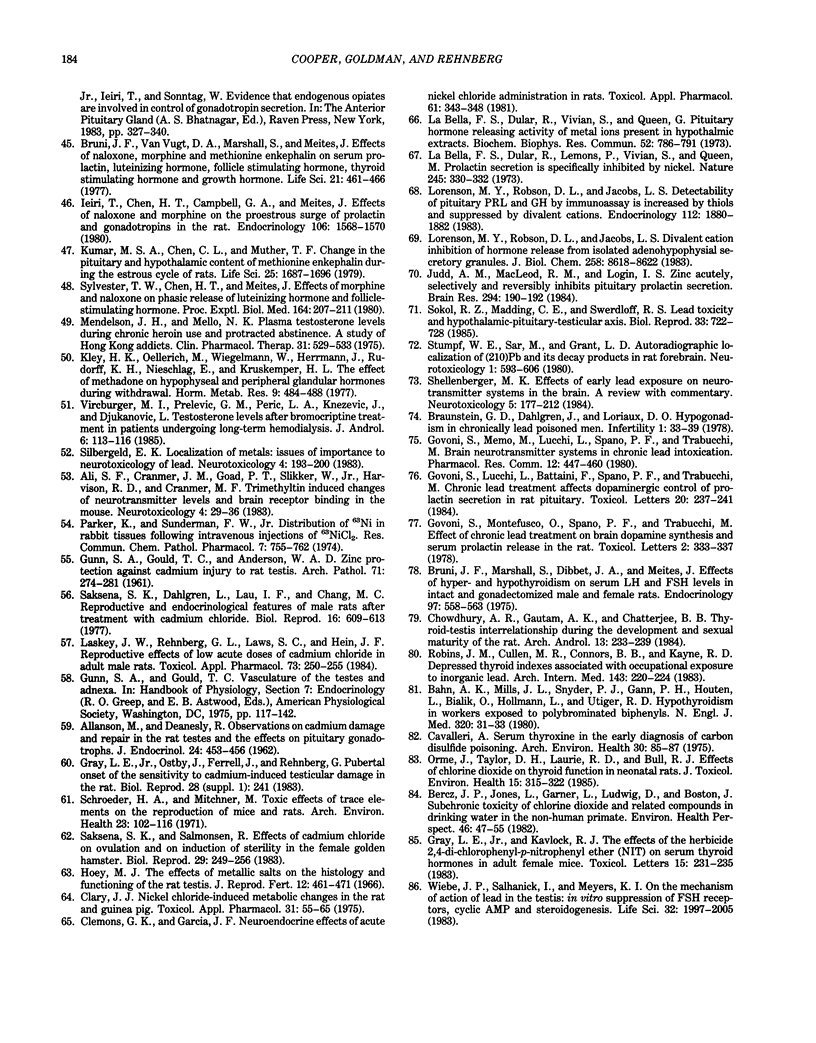
Selected References
These references are in PubMed. This may not be the complete list of references from this article.
- ALLANSON M., DEANESLY R. Observations on cadmium damage and repair in rat testes and the effects on the pituitary gonadotrophs. J Endocrinol. 1962 Jul;24:453–462. doi: 10.1677/joe.0.0240453. [DOI] [PubMed] [Google Scholar]
- Ahluwalia B. S., Rajguru S. U., Nolan G. H. The effect of delta 9-tetrahydrocannabinol in utero exposure on rat offspring fertility and ventral prostate gland morphology. J Androl. 1985 Nov-Dec;6(6):386–391. doi: 10.1002/j.1939-4640.1985.tb03300.x. [DOI] [PubMed] [Google Scholar]
- Ali S. F., Cranmer J. M., Goad P. T., Slikker W., Jr, Harbison R. D., Cranmer M. F. Trimethyltin induced changes of neurotransmitter levels and brain receptor binding in the mouse. Neurotoxicology. 1983 Spring;4(1):29–36. [PubMed] [Google Scholar]
- Ayalon D., Nir I., Cordova T., Bauminger S., Puder M., Naor Z., Kashi R., Zor U., Harell A., Lindner H. R. Acute effect of delta1-tetrahydrocannabinol on the hypothalamo-pituitary-ovarian axis in the rat. Neuroendocrinology. 1977;23(1):31–42. doi: 10.1159/000122652. [DOI] [PubMed] [Google Scholar]
- Bahn A. K., Mills J. L., Snyder P. J., Gann P. H., Houten L., Bialik O., Hollmann L., Utiger R. D. Hypothyroidism in workers exposed to polybrominated biphenyls. N Engl J Med. 1980 Jan 3;302(1):31–33. doi: 10.1056/NEJM198001033020105. [DOI] [PubMed] [Google Scholar]
- Bartke A., Doherty P. C., Steger R. W., Morgan W. W., Amador A. G., Herbert D. C., Siler-Khodr T. M., Smith M. S., Klemcke H. G., Hymer W. C. Effects of estrogen-induced hyperprolactinemia on endocrine and sexual functions in adult male rats. Neuroendocrinology. 1984 Aug;39(2):126–135. doi: 10.1159/000123968. [DOI] [PubMed] [Google Scholar]
- Bartke A., Williams K. I., Dalterio S. Effects of estrogens on testicular testosterone production in vitro. Biol Reprod. 1977 Dec;17(5):645–649. doi: 10.1095/biolreprod17.5.645. [DOI] [PubMed] [Google Scholar]
- Bercz J. P., Jones L., Garner L., Murray D., Ludwig D. A., Boston J. Subchronic toxicity of chlorine dioxide and related compounds in drinking water in the nonhuman primate. Environ Health Perspect. 1982 Dec;46:47–55. doi: 10.1289/ehp.824647. [DOI] [PMC free article] [PubMed] [Google Scholar]
- Bitman J., Cecil H. C. Estrogenic activity of DDT analogs and polychlorinated biphenyls. J Agric Food Chem. 1970 Nov-Dec;18(6):1108–1112. doi: 10.1021/jf60172a019. [DOI] [PubMed] [Google Scholar]
- Braunstein G. D., Dahlgren J., Loriaux D. L. Hypogonadism in chronically lead-poisoned men. Infertility. 1978;1(1):33–51. [PubMed] [Google Scholar]
- Bruni J. F., Marshall S., Dibbet J. A., Meites J. Effects of hyper- and hypothyroidism on serum LH and FSH levels in intact and gonadectomized male and female rats. Endocrinology. 1975 Sep;97(3):558–563. doi: 10.1210/endo-97-3-558. [DOI] [PubMed] [Google Scholar]
- Bruni J. F., Van Vugt D., Marshall S., Meites J. Effects of naloxone, morphine and methionine enkephalin on serum prolactin, luteinizing hormone, follicle stimulating hormone, thyroid stimulating hormone and growth hormone. Life Sci. 1977 Aug 1;21(3):461–466. doi: 10.1016/0024-3205(77)90528-8. [DOI] [PubMed] [Google Scholar]
- Calhoun F. J., Tolson W. W., Darr A. G. Further observations on a uterine response to SKF 525-A and tolbutamide. Life Sci I. 1971 Sep 15;10(18):1045–1049. doi: 10.1016/0024-3205(71)90178-0. [DOI] [PubMed] [Google Scholar]
- Cavalleri A. Serum thyroxine in the early diagnosis of carbon disulfide poisoning. Arch Environ Health. 1975 Feb;30(2):85–87. doi: 10.1080/00039896.1975.10666649. [DOI] [PubMed] [Google Scholar]
- Chowdhury A. R., Gautam A. K., Chatterjee B. B. Thyroid-testis interrelationship during the development and sexual maturity of the rat. Arch Androl. 1984;13(2-3):233–239. doi: 10.3109/01485018408987522. [DOI] [PubMed] [Google Scholar]
- Cicero T. J., Schainker B. A., Meyer E. R. Endogenous opioids participate in the regulation of the hypothalamus-pituitary-luteinizing hormone axis and testosterone's negative feedback control of luteinizing hormone. Endocrinology. 1979 May;104(5):1286–1291. doi: 10.1210/endo-104-5-1286. [DOI] [PubMed] [Google Scholar]
- Clary J. J. Nickel chloride-induced metabolic changes in the rat and guinea pig. Toxicol Appl Pharmacol. 1975 Jan;31(1):55–65. doi: 10.1016/0041-008x(75)90051-4. [DOI] [PubMed] [Google Scholar]
- Clemons G. K., Garcia J. F. Neuroendocrine effects of acute nickel chloride administration in rats. Toxicol Appl Pharmacol. 1981 Dec;61(3):343–348. doi: 10.1016/0041-008x(81)90355-0. [DOI] [PubMed] [Google Scholar]
- Dalterio S., Bartke A., Roberson C., Watson D., Burstein S. Direct and pituitary-mediated effects of delta9-THC and cannabinol on the testis. Pharmacol Biochem Behav. 1978 Jun;8(6):673–678. doi: 10.1016/0091-3057(78)90265-4. [DOI] [PubMed] [Google Scholar]
- Field E., Tyrey L. Delayed sexual maturation in the female rat during chronic exposure to delta-9-tetrahydrocannabinol. Life Sci. 1984 Oct 22;35(17):1725–1730. doi: 10.1016/0024-3205(84)90268-6. [DOI] [PubMed] [Google Scholar]
- GUNN S. A., GOULD T. C., ANDERSON W. A. Zinc protection against cadmium injury to rat testis. Arch Pathol. 1961 Mar;71:274–281. [PubMed] [Google Scholar]
- Gellert R. J. Kepone, mirex, dieldrin, and aldrin: estrogenic activity and the induction of persistent vaginal estrus and anovulation in rats following neonatal treatment. Environ Res. 1978 Jul;16(1-3):131–138. doi: 10.1016/0013-9351(78)90150-0. [DOI] [PubMed] [Google Scholar]
- Govoni S., Lucchi L., Battaini F., Spano P. F., Trabucchi M. Chronic lead treatment affects dopaminergic control of prolactin secretion in rat pituitary. Toxicol Lett. 1984 Mar;20(3):237–241. doi: 10.1016/0378-4274(84)90154-1. [DOI] [PubMed] [Google Scholar]
- Govoni S., Memo M., Lucchi L., Spano P. F., Trabucchi M. Brain neurotransmitter system and chronic lead intoxication. Pharmacol Res Commun. 1980 May;12(5):447–460. doi: 10.1016/s0031-6989(80)80115-9. [DOI] [PubMed] [Google Scholar]
- Gray L. E., Jr, Ferrell J. M., Ostby J. S. Alteration of behavioral sex differentiation by exposure to estrogenic compounds during a critical neonatal period: effects of zearalenone, methoxychlor, and estradiol in hamsters. Toxicol Appl Pharmacol. 1985 Aug;80(1):127–136. doi: 10.1016/0041-008x(85)90107-3. [DOI] [PubMed] [Google Scholar]
- Gray L. E., Jr, Kavlock R. J. The effects of the herbicide 2,4-dichlorophenyl-p-nitrophenyl ether (NIT) on serum thyroid hormones in adult female mice. Toxicol Lett. 1983 Feb;15(2-3):231–235. doi: 10.1016/0378-4274(83)90221-7. [DOI] [PubMed] [Google Scholar]
- Gray L. E., Jr Neonatal chlordecone exposure alters behavioral sex differentiation in female hamsters. Neurotoxicology. 1982 Oct;3(2):67–79. [PubMed] [Google Scholar]
- Guzelian P. S. Comparative toxicology of chlordecone (Kepone) in humans and experimental animals. Annu Rev Pharmacol Toxicol. 1982;22:89–113. doi: 10.1146/annurev.pa.22.040182.000513. [DOI] [PubMed] [Google Scholar]
- HODGE H. C., MAYNARD E. A., THOMAS J. F., BLANCHET H. J., Jr, WILT W. G., Jr, MASON K. E. Short-termporal toxicity tests of methoxychlor (2,2 di-(P-methoxy phenyl)-1,1,1-trichlorethane) in rats and dogs. J Pharmacol Exp Ther. 1950 May;99(1):140–148. [PubMed] [Google Scholar]
- Harris S. J., Cecil H. C., Bitman J. Effect of several dietary levels of technical methoxychlor on reproduction in rats. J Agric Food Chem. 1974 Nov-Dec;22(6):969–973. doi: 10.1021/jf60196a018. [DOI] [PubMed] [Google Scholar]
- Heinrichs W. L., Gellert R. J., Bakke J. L., Lawrence N. L. DDT administered to neonatal rats induces persistent estrus syndrome. Science. 1971 Aug 13;173(3997):642–643. doi: 10.1126/science.173.3997.642. [DOI] [PubMed] [Google Scholar]
- Herbst A. L., Ulfelder H., Poskanzer D. C. Adenocarcinoma of the vagina. Association of maternal stilbestrol therapy with tumor appearance in young women. N Engl J Med. 1971 Apr 15;284(15):878–881. doi: 10.1056/NEJM197104222841604. [DOI] [PubMed] [Google Scholar]
- Hoey M. J. The effects of metallic salts on the histology and functioning of the rat testis. J Reprod Fertil. 1966 Dec;12(3):461–472. doi: 10.1530/jrf.0.0120461. [DOI] [PubMed] [Google Scholar]
- Huang E. S., Nelson F. R. Anti-estrogenic action of chlordecone in rat pituitary gonadotrophs in vitro. Toxicol Appl Pharmacol. 1986 Jan;82(1):62–69. doi: 10.1016/0041-008x(86)90438-2. [DOI] [PubMed] [Google Scholar]
- Hughes C. L., Jr, Everett J. W., Tyrey L. Delta 9-tetrahydrocannabinol suppression of prolactin secretion in the rat: lack of direct pituitary effect. Endocrinology. 1981 Sep;109(3):876–880. doi: 10.1210/endo-109-3-876. [DOI] [PubMed] [Google Scholar]
- Ieiri T., Chen H. T., Campbell G. A., Meites J. Effects of naloxone and morphine on the proestrous surge of prolactin and gonadotropins in the rat. Endocrinology. 1980 May;106(5):1568–1570. doi: 10.1210/endo-106-5-1568. [DOI] [PubMed] [Google Scholar]
- Jackson C. M., Jackson H. Comparative protective actions of gonadotrophins and testosterone against the antispermatogenic action of ethane dimethanesulphonate. J Reprod Fertil. 1984 Jul;71(2):393–401. doi: 10.1530/jrf.0.0710393. [DOI] [PubMed] [Google Scholar]
- Judd A. M., Macleod R. M., Login I. S. Zinc acutely, selectively and reversibly inhibits pituitary prolactin secretion. Brain Res. 1984 Feb 27;294(1):190–192. doi: 10.1016/0006-8993(84)91330-1. [DOI] [PubMed] [Google Scholar]
- Kley H. K., Oellerich M., Wiegelmann W., Herrmann J., Rudorff K. H., Nieschlag E., Krüskemper H. L. The effect of methadone on hypophyseal and peripheral glandular hormones during withdrawal. Horm Metab Res. 1977 Nov;9(6):484–488. doi: 10.1055/s-0028-1093505. [DOI] [PubMed] [Google Scholar]
- Krause W., Hamm K., Weissmüller J. The effect of DDT on spermatogenesis of the juvenile rat. Bull Environ Contam Toxicol. 1975 Aug;14(2):171–179. doi: 10.1007/BF01701310. [DOI] [PubMed] [Google Scholar]
- Kumagai S., Shimizu T. Neonatal exposure to zearalenone causes persistent anovulatory estrus in the rat. Arch Toxicol. 1982 Sep;50(3-4):279–286. doi: 10.1007/BF00310860. [DOI] [PubMed] [Google Scholar]
- Kumar M. S., Chen C. L., Muther T. F. Changes in the pituitary and hypothalamic content of methionine-enkephalin during the estrous cycle of rats. Life Sci. 1979 Nov 5;25(19):1687–1696. doi: 10.1016/0024-3205(79)90410-7. [DOI] [PubMed] [Google Scholar]
- LaBella F. S., Dular R., Lemon P., Vivian S., Queen G. Prolactin secretion is specifically inhibited by nickel. Nature. 1973 Oct 12;245(5424):330–332. doi: 10.1038/245330a0. [DOI] [PubMed] [Google Scholar]
- LaBella F., Dular R., Vivian S., Queen G. Pituitary hormone releasing or inhibiting activity of metal ions present in hypothalamic extracts. Biochem Biophys Res Commun. 1973 Jun 8;52(3):786–791. doi: 10.1016/0006-291x(73)91006-1. [DOI] [PubMed] [Google Scholar]
- Larson P. S., Egle J. L., Jr, Hennigar G. R., Lane R. W., Borzelleca J. F. Acute, subchronic, and chronic toxicity of chlordecone. Toxicol Appl Pharmacol. 1979 Mar 30;48(1 Pt 1):29–41. doi: 10.1016/s0041-008x(79)80005-8. [DOI] [PubMed] [Google Scholar]
- Laskey J. W., Rehnberg G. L., Laws S. C., Hein J. F. Reproductive effects of low acute doses of cadmium chloride in adult male rats. Toxicol Appl Pharmacol. 1984 Apr;73(2):250–255. doi: 10.1016/0041-008x(84)90330-2. [DOI] [PubMed] [Google Scholar]
- Le Fevre R., Coulston F., Golberg L. Action of a copolymer of mixed phenylmethylcyclosiloxanes on reproduction in rats and rabbits. Toxicol Appl Pharmacol. 1972 Jan;21(1):29–44. doi: 10.1016/0041-008x(72)90025-7. [DOI] [PubMed] [Google Scholar]
- Le Vier R. R., Jankowiak M. E. Effects of oral 2,6-cis-diphenylhexamethylcyclotetrasiloxane on the reproductive system of the male rat. Toxicol Appl Pharmacol. 1972 Jan;21(1):80–88. doi: 10.1016/0041-008x(72)90029-4. [DOI] [PubMed] [Google Scholar]
- Lorenson M. Y., Robson D. L., Jacobs L. S. Detectability of pituitary PRL and GH by immunoassay is increased by thiols and suppressed by divalent cations. Endocrinology. 1983 May;112(5):1880–1882. doi: 10.1210/endo-112-5-1880. [DOI] [PubMed] [Google Scholar]
- Lorenson M. Y., Robson D. L., Jacobs L. S. Divalent cation inhibition of hormone release from isolated adenohypophysial secretory granules. J Biol Chem. 1983 Jul 25;258(14):8618–8622. [PubMed] [Google Scholar]
- Mendelson J. H., Mello N. K. Plasma testosterone levels during chronic heroin use and protracted astinence. A study of Hong Kong addicts. Clin Pharmacol Ther. 1975 May;17(5):529–533. doi: 10.1002/cpt1975175529. [DOI] [PubMed] [Google Scholar]
- Morrell J. I., Schwanzel-Fukuda M., Fahrbach S. E., Pfaff D. W. Axonal projections and peptide content of steroid hormone concentrating neurons. Peptides. 1984;5 (Suppl 1):227–239. doi: 10.1016/0196-9781(84)90281-x. [DOI] [PubMed] [Google Scholar]
- Ojeda S. R., Andrews W. W., Advis J. P., White S. S. Recent advances in the endocrinology of puberty. Endocr Rev. 1980 Summer;1(3):228–257. doi: 10.1210/edrv-1-3-228. [DOI] [PubMed] [Google Scholar]
- Orme J., Taylor D. H., Laurie R. D., Bull R. J. Effects of chlorine dioxide on thyroid function in neonatal rats. J Toxicol Environ Health. 1985;15(2):315–322. doi: 10.1080/15287398509530657. [DOI] [PubMed] [Google Scholar]
- Parker K., Sunderman F. W., Jr Distribution of 63Ni in rabbit tissues following intravenous injection of 63NiCl2. Res Commun Chem Pathol Pharmacol. 1974 Apr;7(4):755–762. [PubMed] [Google Scholar]
- Pfaff D., Keiner M. Atlas of estradiol-concentrating cells in the central nervous system of the female rat. J Comp Neurol. 1973 Sep 15;151(2):121–158. doi: 10.1002/cne.901510204. [DOI] [PubMed] [Google Scholar]
- Robins J. M., Cullen M. R., Connors B. B., Kayne R. D. Depressed thyroid indexes associated with occupational exposure to inorganic lead. Arch Intern Med. 1983 Feb;143(2):220–224. [PubMed] [Google Scholar]
- Saksena S. K., Dahlgren L., Lau I. F., Chang M. C. Reproductive and endocrinological features of male rats after treatment with cadmium chloride. Biol Reprod. 1977 Jun;16(5):609–613. doi: 10.1095/biolreprod16.5.609. [DOI] [PubMed] [Google Scholar]
- Saksena S. K., Salmonsen R. Effects of cadmium chloride on ovulation and on induction of sterility in the female golden hamster. Biol Reprod. 1983 Aug;29(1):249–256. doi: 10.1095/biolreprod29.1.249. [DOI] [PubMed] [Google Scholar]
- Schroeder H. A., Mitchener M. Toxic effects of trace elements on the reproduction of mice and rats. Arch Environ Health. 1971 Aug;23(2):102–106. doi: 10.1080/00039896.1971.10665963. [DOI] [PubMed] [Google Scholar]
- Shellenberger M. K. Effects of early lead exposure on neurotransmitter systems in the brain. A review with commentary. Neurotoxicology. 1984 Fall;5(3):177–212. [PubMed] [Google Scholar]
- Silbergeld E. K. Localization of metals: issues of importance to neurotoxicology of lead. Neurotoxicology. 1983 Fall;4(3):193–200. [PubMed] [Google Scholar]
- Smith C. G., Besch N. F., Smith R. G., Besch P. K. Effect of tetrahydrocannabinol on the hypothalamic-pituitary axis in the ovariectomized rhesus monkey. Fertil Steril. 1979 Mar;31(3):335–339. doi: 10.1016/s0015-0282(16)43885-9. [DOI] [PubMed] [Google Scholar]
- Smith C. G. Reproductive toxicity: hypothalamic-pituitary mechanisms. Am J Ind Med. 1983;4(1-2):107–112. [PubMed] [Google Scholar]
- Sokol R. Z., Madding C. E., Swerdloff R. S. Lead toxicity and the hypothalamic-pituitary-testicular axis. Biol Reprod. 1985 Oct;33(3):722–728. doi: 10.1095/biolreprod33.3.722. [DOI] [PubMed] [Google Scholar]
- Sylvester P. W., Chen H. T., Meites J. Effects of morphine and naloxone on phasic release of luteinizing hormone and follicle-stimulating hormone. Proc Soc Exp Biol Med. 1980 Jun;164(2):207–211. doi: 10.3181/00379727-164-40849. [DOI] [PubMed] [Google Scholar]
- Tyrey L. delta-9-Tetrahydrocannabinol suppression of episodic luteinizing hormone secretion in the ovariectomized rat. Endocrinology. 1978 Jun;102(6):1808–1814. doi: 10.1210/endo-102-6-1808. [DOI] [PubMed] [Google Scholar]
- Vircburger M. I., Prelević G. M., Perić L. A., Knezević J., Djukanović L. Testosterone levels after bromocriptine treatment in patients undergoing long-term hemodialysis. J Androl. 1985 Mar-Apr;6(2):113–116. doi: 10.1002/j.1939-4640.1985.tb00825.x. [DOI] [PubMed] [Google Scholar]
- Wiebe J. P., Salhanick A. I., Myers K. I. On the mechanism of action of lead in the testis: in vitro suppression of FSH receptors, cyclic AMP and steroidogenesis. Life Sci. 1983 Apr 25;32(17):1997–2005. doi: 10.1016/0024-3205(83)90051-6. [DOI] [PubMed] [Google Scholar]


